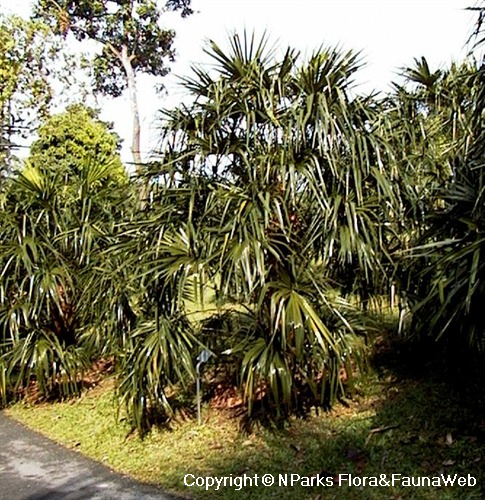
Back
Livistona australis (R.Br.) Mart.
| Family Name: | Arecaceae (Palmae) |
| Synonyms: | Corypha australis R.Br. |
| Common Name: | Cabbage Palm, Australian Cabbage Palm |
Livistona australis , also known as Cabbage Palm, is a solitary palm that can reach up to 25 m tall. The fibres are used by early European settlers in Australia to make cabbage tree hat, the first distinctive Australian headwear in use. It is a highly prized plant in many gardens and collections in Europe during the 19th century.
Name
Classifications and Characteristics
| Plant Division | Angiosperms (Flowering Seed Plants) |
|---|---|
| Plant Growth Form | Palm |
| Lifespan (in Singapore) | Perennial |
| Mode of Nutrition | Autotrophic |
| Maximum Height | 25 m |
Biogeography
| Native Distribution | Australia |
|---|---|
| Native Habitat | Terrestrial |
| Preferred Climate Zone | Tropical |
| Local Conservation Status | Non-native |
Description and Ethnobotany
| Growth Form | It is a palm that can reach up to 25 m tall and has a solitary growth habit. Petiole stubs remain on the stem even after the leaves fall off. These stubs may fall off gradually with time. The stem is ringed with narrow leaf scars and prominent longitudinal fissures. |
|---|---|
| Foliage | Leaves are fan-shaped (costapalmate), about 1 – 1.3 m long, and deeply divided for 49 – 69% of the length. Leaves are regularly segmented and can have 80 – 100 segments each. The tip of the segment is pendulous. The petiole can reach up to 2.5 m long and are armed with curved short black spines along the margin. Sheet-like fibers are prominent and persistent at the base of the petiole. |
| Flowers | Inflorescence occurs between the leaves (interfoliar) and can reach 1.4 – 2.5 m long. It comprises of many small white to pale yellow flowers. Flower is funnel-shaped with fleshy petals and sepals. |
| Fruit | Fruit is round (about 1.2 – 2.2 cm diameter) with scattered lenticellular pores and suture line. The fruit is red and turns dull reddish brown to black at maturity. Each fruit contains 1 seed within. |
| Habitat | It is found in rainforest, swamp forest, coastal forests and along streams, up to 1000 m altitude. |
| Associated Fauna | Flowers are pollinated by insects. |
| Cultivation | It is the first palm mentioned in European accounts of Australia and a highly prized plant in many gardens and collections in Europe during the 19th century. The first successful cultivation of L. australis at Kew was documented in 1824. The seeds were unintentionally used as drainage crocks in containers of other Australian plants and germinated by chance during the voyage to England. In a span of a few years, the palm became commercially available in England. |
| Etymology | The genus commemorates Sir Patrick Murray (1632 – 1671), 2nd Lord of Elibank and 17th century Baron of Livingstone, who donated his private plant collection after his death and helped found the Edinburgh Botanic Garden. The specific epithet refers to Australia, the place where it occurs naturally. |
| Ethnobotanical Uses | Cultural / Religious: The fibres are used by early European settlers in Australia to make cabbage tree hat, the first distinctive Australian headwear in use. The fibres were first boiled, dried and bleached, before weaving them into hats. Others: The young tender leaves and growing point are traditionally eaten like cabbages by indigenous people in Australia. It can be consumed raw or cooked. |
Landscaping Features
| Usage Hazard - Cons | Spines/Thorns - Leaf |
|---|
Fauna, Pollination and Dispersal
| Pollination Method(s) | Biotic (Fauna) |
|---|
Plant Care and Propagation
| Light Preference | Full Sun |
|---|---|
| Water Preference | Moderate Water |
| Plant Growth Rate | Moderate |
Foliar
| Mature Foliage Colour(s) | Green |
|---|---|
| Foliar Shape(s) | Palm Fronds (Fan / Costapalmate) |
| Leaf Area Index (LAI) for Green Plot Ratio | 2.5 (Palm - Solitary) |
Non - Foliar and Storage
| Trunk Type (Palm) | Solitary Habit, Aboveground |
|---|
Fruit, Seed and Spore
| Mature Fruit Colour(s) | Black, Red, Brown |
|---|---|
| Seed Quantity Per Fruit | Few (1-5) |
References
| References | Dowe, J.L. (2009). A taxonomic account of Livistona R.Br. (Arecaceae). Gardens' Bulletin Singapore 60: 185-344. Dowe, J.L. & Schlumpberger, B.O. (2018). Livistona australis in 19th Century Europe, a Horticultural VIP. Palms 64 (4): 161 – 173 |
|---|
Image Repository
Others
| Master ID | 1355 |
|---|---|
| Species ID | 2648 |
| Flora Disclaimer | The information in this website has been compiled from reliable sources, such as reference works on medicinal plants. It is not a substitute for medical advice or treatment and NParks does not purport to provide any medical advice. Readers should always consult his/her physician before using or consuming a plant for medicinal purposes. |
